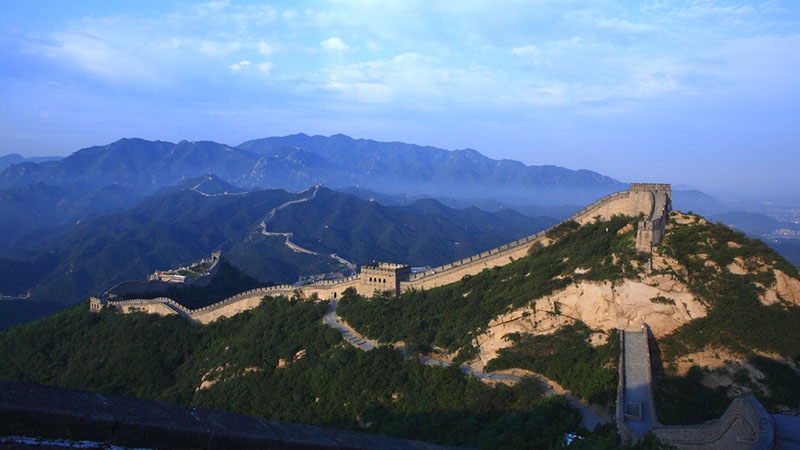008613762194311 | 008613762194311 tour-zhangjiajie@outlook.com
008613762194311 | 008613762194311 tour-zhangjiajie@outlook.com
【Location】Guangou Road, Jundushan District, Beijing
【Type】 World Heritage Site, Ancient Architecture
【Rank】 ★★★★★
【Completion date】 in 446
【Recommended Time to stay】 3--4 hours
【Opening Hours】
• Each April to October: 6:30-17:00
• Each November to March: 6:30-17:00
The Great Wall snakes its way across northern China, from the Yellow Sea and past the Gobi Desert for some 6,000km. White it's not visible from the moon as has been claimed, it's still a remarkable piece of engineering and is the most famous symbol of China.The genesis of the Great Wall dates to the Warring States period from 475 to 221BC, when Chinese feudal kingdoms built earthen ramparts to defend against nomadic in-vaders. It was under the fierce emperor Qinshihuang, who unified China in 221BC that the Great Wall really began to take shape. He conscripted some 300,000 laborers to work for ten years on joining the various pre-existing sections into a single fortified wall. The suffering of the workers who toiled in freezing winters and scorching summers became legendary.
 As dynasty came into being and passed into history, the Great Wall was continuously repaired and extended.The sections of the Great Wall near Beijing were renovated during the Ming dynasty, whose leaders spend a century strengthening and extending the Wall to the Yellow Sea. The previous ramparts, which were made of stones, packed earth and wood, were covered by Ming builders with bricks. They built crenellations to protect archers, widened the Wall so it cold accomodate five horses areast, and added many watchtowers. A system if beacons lit from tower to tower ensured hat enemy troop movements were swiftly relayed to headquarters.Despite such defensive features, the Great Wall failed in its purpose of keeping out invaders. It was breached several times, notably by the armies of Genghis Khan in 1215 and by Manchu troops in 1644. Conversely, the Great Wall was a tremendous success in forging a sense of nationhood since it marked the physical boundary between China and abroad, and the psychological boundary between civilization and chaos. Scaling forbidding landscapes of mountains and deserts, the Great Wall was also a triumph of the emperor's will over nature.
As dynasty came into being and passed into history, the Great Wall was continuously repaired and extended.The sections of the Great Wall near Beijing were renovated during the Ming dynasty, whose leaders spend a century strengthening and extending the Wall to the Yellow Sea. The previous ramparts, which were made of stones, packed earth and wood, were covered by Ming builders with bricks. They built crenellations to protect archers, widened the Wall so it cold accomodate five horses areast, and added many watchtowers. A system if beacons lit from tower to tower ensured hat enemy troop movements were swiftly relayed to headquarters.Despite such defensive features, the Great Wall failed in its purpose of keeping out invaders. It was breached several times, notably by the armies of Genghis Khan in 1215 and by Manchu troops in 1644. Conversely, the Great Wall was a tremendous success in forging a sense of nationhood since it marked the physical boundary between China and abroad, and the psychological boundary between civilization and chaos. Scaling forbidding landscapes of mountains and deserts, the Great Wall was also a triumph of the emperor's will over nature.
There are three major sections of the Great Wall open to tourists near Beijing: Badaling, Mutianyu and Simatai. All three are built on steep terrain so it's a good idea to wear comfortable shoes and bring water. This advice holds especially true when going to the Simatai section or to the" Wild Wall' sections that haven't been restored. Many ex-pats enjoy hiking along the "Wild Wall" but it's not for the faint of heart: climbing conditions can be arduous and there are no signposts, so hikers will need a good map or a guide.Whatever section you choose to visit, the simplest way to get there is to hire a car and driver for the day. Depending on the type of vehicle and the distance to be covered, except to pay anywhere from RMB 700 to 1500(plus an additional RMB 500 for the guide).
★Three major sections of Great Wall
Badaling Section
Badaling only 70km away by superhighway, which is the closest section of the Great Wall to Beijing and can be visited in half a day. Moreover, its proximity to the Ming Tombs means both sites can be seen in a single outing. Badaling was completely restored after 1957. It has a chairlift and fast food restaurants can be crowded with hawkers and tourists, but all that fades away once you leave the parking area and begin to walk along the wall.
Mutianyu Section
Mutianyu is located some 90km north of Beijing, and like Badaling, is a recently renovated section that's very popular. Mutianyu lies in rugged territory and reaching the Wall from the main gate involves a strenuous climb up a steep stairway, but fortunately there's a chairlift. Once on top, the views of the Wall undulating down wooded canyons and up mountain ridges are breathtakig.
Simatai Section
The Simatai section is a dramatic testimony to Ming engineering skills with one section as steep as 85 degrees. Only partially restored, Simatai allows athletic visitors who climb past the first watchtowers to see the wall in its wild, crumbling state. Less intrepid visitors can take a gondola. Simatai is 110km northwest of Beijing City.
Previous Page:Forbidden City
Next Page:Beihai Park